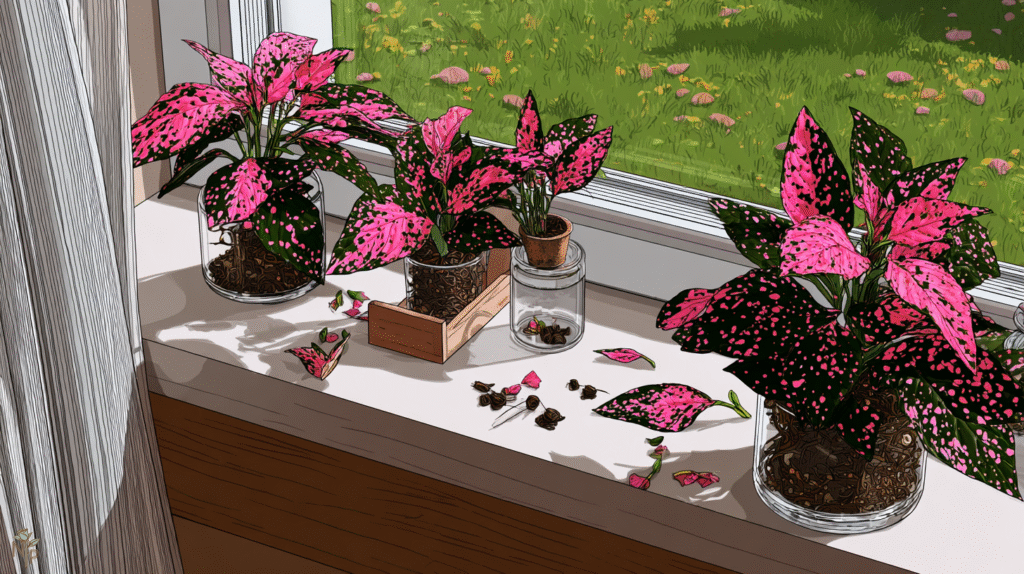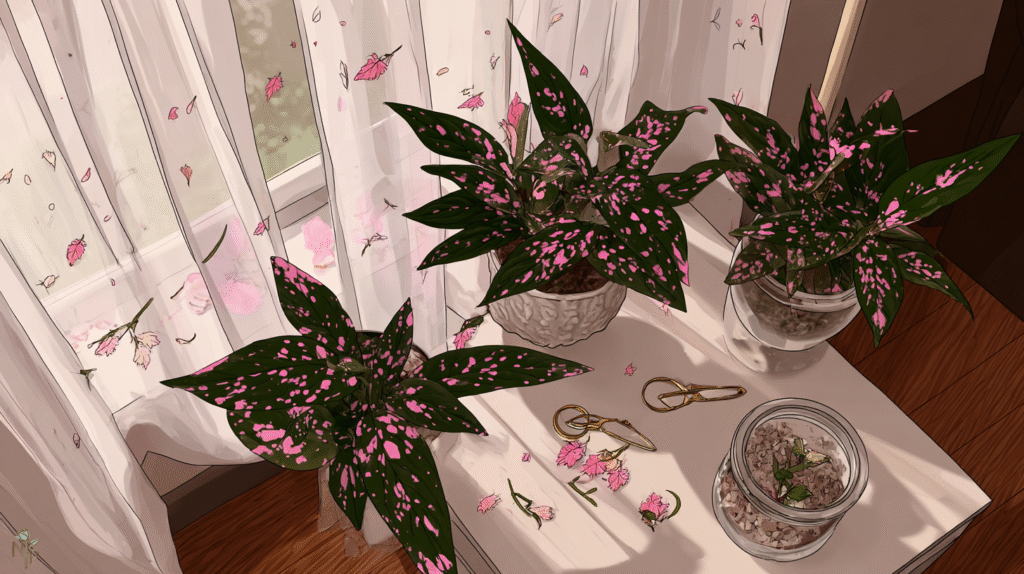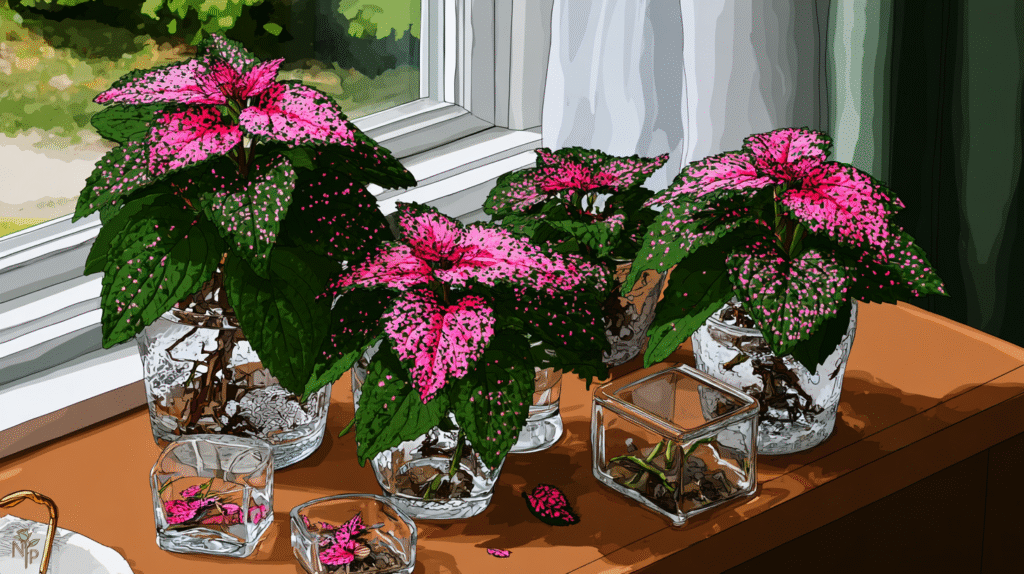My polka dot plant saga started with love at first sight. Those pink-speckled leaves at the grocery store checkout? Impossible to resist. “How hard could it be?” I thought, adding it to my cart between the milk and bananas.
Forty-eight hours later, my perky pink plant looked like it had given up on life. Drooping so dramatically I thought it was dying. Turns out, polka dot plants (Hypoestes phyllostachya) are the theater kids of the houseplant world — everything is a performance, and they WILL let you know how they feel about your care.
Three years and seven polka dot plants later (yes, I kept buying them despite the drama), I finally understand their language. They’re actually not difficult — they’re just extremely expressive. Once you learn to read their dramatic signals, they become one of the most rewarding houseplants you can grow. Here’s everything I’ve learned about keeping these spotted divas happy indoors.

Understanding the Drama Queen Personality
Before we dive into care, you need to understand what you’re dealing with. Polka dot plants communicate like no other houseplant:
Happy: Perky leaves, vibrant colors, standing proud Thirsty: Full Victorian swoon, complete collapse Too dry: Crispy edges while still managing to look offended Too wet: Yellowing with an air of betrayal Not enough light: Colors fading like they’re personally disappointed in you
My first polka dot plant taught me this in two days. Day one: gorgeous. Day two: completely horizontal. I panicked, doused it with water, and watched it spring back to life within hours like nothing happened. That’s when I realized — this wasn’t a plant problem, it was a communication style.
Watering: The Daily Drama
This is where most people either give up or fall in love with polka dot plants. They’re thirsty little things with zero chill about it.
The reality of watering:
- Check daily (yes, really)
- They want consistently moist soil
- Never soggy, never bone dry
- Will literally faint when thirsty
My watering routine: I check every morning with my coffee. Stick my finger in the soil — if the top inch is dry, it’s water time. In summer, that’s every 2-3 days. In winter, maybe every 4-5 days. But honestly? The plant tells you. That dramatic wilt? That’s your cue.
The recovery miracle: First time mine collapsed, I thought it was dead. Watered it, went to make lunch, came back to a perfectly perky plant. Now I find the drama amusing. It’s like having a very expressive roommate.
Light: More Important Than You Think
The tag said “low light tolerant.” The tag lied. Or at least stretched the truth. Polka dot plants will survive in low light, but their colors will fade faster than cheap hair dye.
What actually works:
- Bright, indirect light = vibrant colors
- Medium light = colors fade but still pretty
- Low light = might as well get a plain green plant
- Direct sun = crispy drama queen
My pink polka dot in the bathroom with just a frosted window? Turned mostly green within a month. Moved to 3 feet from an east window? Pink spots came back like magic. These plants need good light to keep their spots vibrant.
The rotation ritual: Turn the pot a quarter turn weekly. Otherwise, it leans toward light like a teenager taking a selfie. Learned this after mine grew completely lopsided.
Humidity: The Secret to Less Drama
Want to reduce the dramatic wilting episodes? Humidity is your answer. These tropical origins show — they love moisture in the air.
Humidity hacks that work:
- Bathroom placement (if you have good light)
- Humidifier nearby
- Pebble tray with water
- Grouping with other plants
My polka dots near the humidifier wilt maybe once a week. The one in my dry living room? Daily drama performances. I’ve accepted both scenarios, but humidity definitely equals less maintenance.
Temperature: Goldilocks Syndrome
Polka dot plants are picky about temperature. Not too hot, not too cold, just right.
The sweet spot:
- 65-75°F is perfect
- Below 60°F = unhappy plant
- Above 80°F = wilting even with water
I learned this when my plant near the heating vent went from happy to crispy in one winter week. Now they live away from all vents, drafts, and temperature extremes. Room temperature rooms only.
Soil and Potting: Getting the Foundation Right
After killing two polka dots with root rot (overcompensating for their thirstiness), I learned soil matters:
The right mix:
- Regular potting soil is fine
- Add some perlite for drainage
- Needs to retain moisture but not get swampy
Pot selection:
- Must have drainage holes
- Not too big — they like cozy roots
- I use plastic pots inside decorative ones (holds moisture better than terracotta)
That gorgeous pot with no drainage? That’s a polka dot death trap. Trust me, I’ve been there.
Pruning: The Secret to Bushy Beauty
Nobody told me polka dot plants get leggy fast without pruning. My first one turned into a sparse, stretched mess reaching for light.
Pinching for fullness:
- Pinch growing tips every few weeks
- Removes flowers before they bloom (flowers = energy drain)
- Each pinch creates two new branches
- More branches = fuller plant
First time I pinched mine, I felt like a monster. Now I’m pinch-happy. The result? Bushy, full plants instead of leggy disappointments.
About those flowers: Polka dots produce tiny purple flowers. Cute, but they signal the plant’s preparing to die (they’re often grown as annuals). Pinch them off immediately. I let one bloom out of curiosity — the plant declined rapidly after. Never again.
Common Problems I’ve Faced (And Fixed)
Losing color:
- Usually needs more light
- Sometimes overfertilizing
- Move gradually to brighter spot
Crispy edges:
- Low humidity or underwatering
- Increase humidity first
- Check watering routine
Yellowing leaves:
- Usually overwatering
- Let soil dry out more between waterings
- Check for root rot if severe
Leggy growth:
- Not enough light
- Needs pruning
- Both together for best results
Complete collapse:
- Just thirsty (usually)
- Water and wait 2 hours
- If no recovery, check roots
Propagation: Making More Drama Queens
This is where polka dots redeem themselves — propagation is stupid easy:
- Cut 4-inch stem with several leaves
- Remove lower leaves
- Stick in water or moist soil
- Roots in 1-2 weeks
- New dramatic plant in 3-4 weeks
I propagate constantly because these plants share well. Everyone wants a cutting of the “fainting plant.” Success rate is nearly 100% in spring/summer.

Seasonal Care Adjustments
Spring/Summer:
- Growth explosion
- Need more water
- Fertilize monthly (diluted)
- Pinch constantly
Fall/Winter:
- Growth slows
- Water less frequently
- Stop fertilizing
- Still needs good light
Understanding seasonal changes reduced my plant stress significantly. Winter wilting is less frequent — they’re just not as thirsty.
Living with the Drama
After three years, I’ve made peace with polka dot dramatics. Yes, they wilt dramatically. Yes, they demand attention. But they also:
- Recover instantly when watered
- Grow incredibly fast
- Propagate easily
- Add amazing color to spaces
- Make great conversation starters
My collection has grown from one grocery store impulse buy to five different varieties in various colors. Each has its own personality, but all share that signature dramatic flair.
Your Polka Dot Success Plan
Ready to embrace the drama? Here’s your roadmap:
- Place in bright, indirect light
- Check soil moisture daily
- Water when top inch is dry
- Pinch regularly for bushiness
- Remove flowers immediately
- Accept the wilting as communication, not crisis
That first polka dot plant that almost gave me a heart attack? Its great-grandchildren now live all over my house. Once you understand their theatrical nature, polka dot plants become less stressful and more entertaining.
They’re not for everyone. If you want a chill, low-maintenance plant, look elsewhere. But if you enjoy responsive plants that clearly communicate their needs (dramatically), polka dots might be perfect. Just be prepared for the most expressive houseplant relationship you’ll ever have. 🎭







